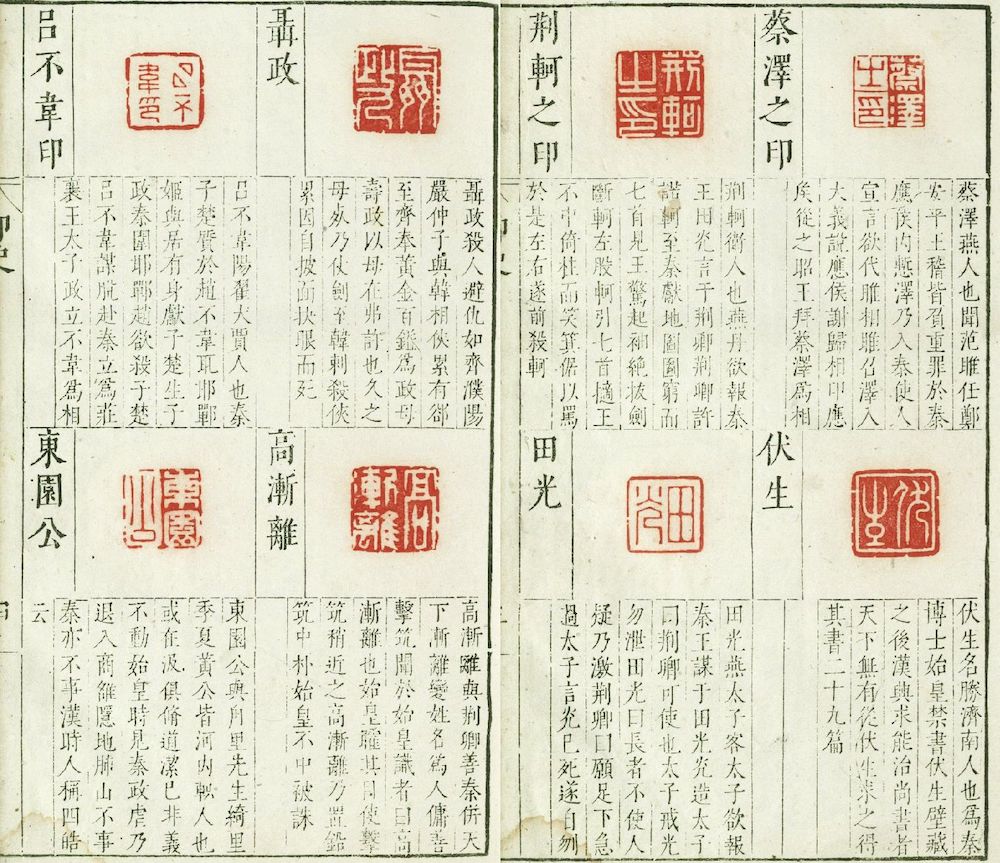Yinshi 印史 "A history in seals" is a seal album in combination with a history book compiled during the Ming period 明 (1368-1644) by He Tong 何通 (fl. 1623), courtesy name Buwei 不違 (also written 不韋). He hailed from Songjiang 松江 near Shanghai, and was originally a servant of Wang Xijue 王錫爵 (1534-1610), from whose private collection he learned a lot about history and arts, and developed a special interest in ancient seals.
The book is also called He Tong yinshi 何通印史 in order to discern it from other books with the same title, namely the works of Zhao Mengfu 趙孟頫 (1254—1322; lost), Wen Peng 文彭 (1498—1573), and of Tong Changling 童昌齡 (c. 1650—after 1708).
His book of 5 (6) juan length, finished in 1623, is a combination of short biographies of important historical personalities with their "private seals". The seals were not originals, but were produced by He Tong in imitation of ancient styles. The book covers persons through the ages, from the late Warring States 戰國 (5th cent.-221 BCE) to the Yuan period 元 (1279-1368). Besides a reproduction of the seal, the book provides a small biography of each person. The seals are not in any case arranged chronologically; for instance, Li Si 李斯 (d. 208 BCE) appears before Shang Yang 商鞅 (c. 390-338 BCE). The headline Shangshan si hao 商山四皓 is not followed by all four "old men from Mt. Shangshan", but only by two of them (Dongyuan Gong 東園公, and Qiji Li 綺里季). There are some other mistakes in the names of persons that were unusual for the period, for instance, mixing courtesy names with personal names or creating line breaks in two-syllable names. He Tong makes mistakes in his reproduction of Han-period 漢 (206 BCE-220 CE) seals, especially in the case of seals that include two names or a person with a two-syllable family name. The seal script style (zhuanwen 篆文) of Han-period seals is often rendered in the "bell-and-tripod style" (zhongding wen 鐘鼎文), and not in the contemporary seal script or chancery script (lishu 隸書).
 |
The seals are not originals, but imitate more or less successfully contemporary styles. He's book is thus a combination of history book and artbook. Source: Guangming zhi men 光明之門. Copy owned by Berkeley Library. |
It can thus be seen that the images of the book are not based on originals, but according to He's fantasy. The text was therefore not included in the imperial series Siku quanshu 四庫全書, but it is to be found in the series Xunyan yinxue congshu 遁盦印學叢書. The beauty of He's pseudo-reproduction nonetheless attracted the attention of many scholars. There are no fewer than eight prefaces or afterwords written in the late Ming period, namely the dated prefaces by Chen Yuansu 陳元素, Su Xuan 蘇宣, and Cheng Ben 陳本, and the undated ones by Zhu Jian 朱簡, Chen Wanyan 陳萬言, Wang Liang 王亮, Shen Cheng 沈承, and a master called Tongyin Jushi 通隱居士.